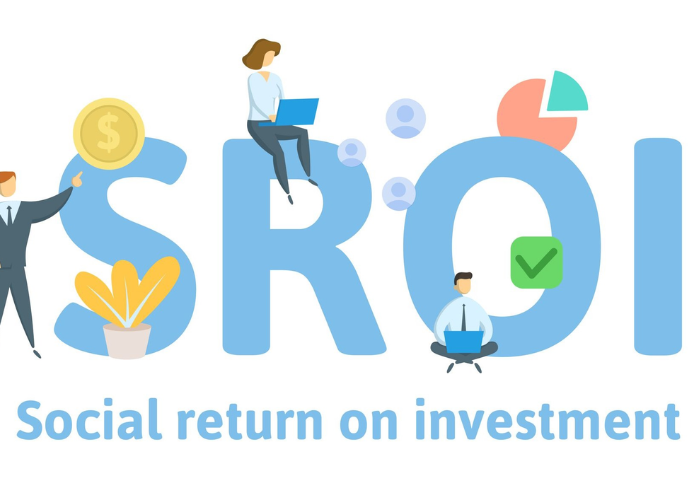The business world has changed. The pandemic is forcing people to transform their businesses in unprecedented ways. Social media has drastically altered how and why businesses market, sell, and reach customers.
The most successful businesses are dynamically transforming to meet new expectations and overcome strain. How successful is your business in this brave new world? How do you measure your social return on investment?
It’s important to measure your social return on investment (SROI) and understand the numbers behind your social media. Social media is an investment of your time, money, and reputation. Your SROI can expand or limit your business.
Keep reading to learn more about what social ROI is and how to calculate it for your own business.
What is Social Return on Investment?
Social Return on Investment (SROI) is an economic tool used to measure the impacts of investments made to achieve a social goal. The goal could be anything from providing basic services to training. It could also be the development initiatives that lead to long-term impacts.
This tool is used to measure the return on any particular investment to the community. It takes into consideration the cost of any project, the ‘stakeholder’s’ inputs or costs, the economic benefits, and the qualitative non-financial sphere. SROI is often used when determining the return from charity activities and evaluating social policies.
The aim is to quantify the impact of a project on goals set before implementation. It also aims to compare projects against a baseline. SROI is often used for public sector activities and organizations operating in the non-profit space.
How is SROI Calculated?
SROI calculation can be a complex process, but you can easily measure social return on investment by following these few key steps:
- Define the Scope
Begin by clearly defining the scope and objectives of the project or organization you want to evaluate. What are the intended social and environmental outcomes?
- Engage Stakeholders
Identify and engage with all relevant stakeholders, including beneficiaries, investors, and community members. Their input is crucial in determining the social value created.
- Input Data
Gather data on both financial and non-financial outcomes. This might include metrics such as reduced pollution, increased access to education, or improved health.
- Monetize Outcomes
Assign a monetary value to these non-financial outcomes. This can be a challenging step, as it involves making assumptions and using various valuation methods.
- Calculate SROI Ratio
Divide the social value created by the cost of the project or investment. This gives you the SROI ratio, which represents how much social value is generated for every unit of cost.
- Interpret and Communicate
Interpret the SROI ratio and use it to communicate the social and environmental impact to stakeholders and the wider public.
Why is SROI Important?
Now that we understand what SROI is let’s explore why it’s gaining importance:
- Holistic Impact Assessment
SROI provides a more comprehensive picture of an organization’s impact. It goes beyond profit margins to consider the broader benefits and costs associated with a project or initiative.
- Improved Decision-Making
By including social and environmental factors in decision-making, organizations can make more informed choices that align with their values and long-term sustainability.
- Attracting Impact Investors
Impact investors are increasingly looking for opportunities that not only generate financial returns but also contribute positively to society. SROI helps organizations attract such investors.
- Enhanced Accountability
SROI holds organizations accountable for their social and environmental commitments. It allows stakeholders to assess whether promises are being met.
- Benchmarking and Learning
SROI encourages organizations to benchmark their performance against industry standards and learn from best practices, ultimately driving continuous improvement.
The Challenges of SROI
While SROI is a powerful tool for measuring social impact, it comes with its own set of challenges:
- Subjectivity
Monetizing social and environmental benefits is often subjective and can vary significantly depending on the methodology used.
- Data Collection
Gathering the necessary data to calculate SROI can be time-consuming and costly, especially for long-term projects.
- Complexity
SROI calculations can be intricate, involving multiple variables and assumptions. This complexity can deter organizations from adopting the methodology.
- Contextual Differences
SROI may not be universally applicable. What’s considered a positive social impact in one context might not hold true in another.
Significant Role of SROI
Mergers and acquisitions (M&A) are complex transactions where companies are bought, sold, or combined. Traditionally, the focus in M&A has been on financial due diligence, assessing the value of assets, liabilities, and potential synergies.
However, the social and environmental impacts of M&A activity are increasingly gaining attention. They often focus on financial gains, but SROI can play a crucial role in these activities as well. By calculating the SROI, companies engaged in M&A can:
- Assess Social Risks
Identify potential social and environmental risks associated with the merger or acquisition, allowing for proactive mitigation strategies.
- Evaluate Alignment
Determine if the values and social missions of the two companies align. Mismatches can lead to cultural clashes and negative social impacts.
- Engage Stakeholders
Involve stakeholders from both organizations in the process to understand their concerns and expectations regarding the merger’s social impact.
- Quantify Benefits
Quantify the expected social and environmental benefits of the merger or acquisition, allowing for better communication with investors and regulators.
Real World Examples
Several organizations have embraced SROI to showcase their commitment to social and environmental responsibility. One notable example is Patagonia, the outdoor clothing company. Patagonia’s SROI analysis revealed that for every dollar spent on their environmental initiatives, they returned $10 to society in the form of reduced carbon emissions and other ecological benefits.
Another instance is the Grameen Bank, founded by Muhammad Yunus, which provides microloans to impoverished communities. SROI analysis of Grameen Bank’s activities found that the benefits far exceeded the initial investment.
SROI Transformative Potential
In conclusion, social return on investment is a valuable tool that can help organizations measure the impact of their work beyond financial metrics. Not only can it be used to assess the direct economic impact of a project, but it can also help to factor in social cost-benefits. Investors, funders, and organizations should all consider using analysis based on SROI to measure their impact more effectively.
Start leveraging SROI in your business model today to unlock the potential of your social impact. Let’s start working together now. Let’s create a bigger, better future! If you find this article helpful, check out the rest of our site for more blogs like this one.




